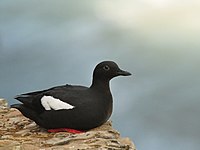
Photo from wikipedia
Background and Aim: Nowadays, toxic chemical contaminants in food are a major food safety problem in Bangladesh. Among toxic food contaminants, formalin is used to preserve fruit, vegetables, and fish,… Click to show full abstract
Background and Aim: Nowadays, toxic chemical contaminants in food are a major food safety problem in Bangladesh. Among toxic food contaminants, formalin is used to preserve fruit, vegetables, and fish, where urea is used for the whitening of rice and puffed rice. The purpose of this study was to determine the biochemical and histopathological effects on the liver of young and adult pigeons after exposure to formalin and urea contaminated feed. Materials and Methods: A total of 15 young and 15 adult pigeons were divided into control group, formaldehyde exposed group (2.5 mL formalin/kg feed), and urea exposed (1 g/kg feed) group. Each group consisted of five pigeons. After the experimentation procedures, the blood samples were collected for biochemical study, and the liver tissue was collected for histomorphological study. The statistical analysis was performed using the Student’s t-test, and p<0.05 was considered as statistically significant. Results: The aspartate transaminase serum hepatic enzyme was significantly increased in both formalin and urea exposed young and adult pigeons than the control pigeons. In control pigeons, parenchymal hepatocytes and non-parenchymal cells are regularly arranged. However, histological observation of the liver of formalin and urea exposed young, and adult pigeons showed coagulation necrosis with infiltration of many inflammatory cells around the central and portal veins. The necrotic areas are more extensive with massive infiltration of inflammatory cells in the liver of formalin-treated pigeons than the urea treated pigeons. Conclusion: The present study results show that low concentrations of formalin and urea in feed induced liver lesions in pigeons in different extents and indicate that exposure to toxic chemicals may affect homeostasis of the liver and cause liver injury or act as a co-factor for liver disease.
Journal Title: Veterinary World
Year Published: 2021
Link to full text (if available)
Share on Social Media: Sign Up to like & get
recommendations!